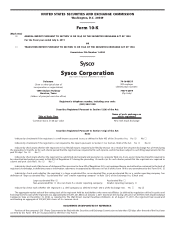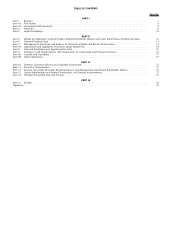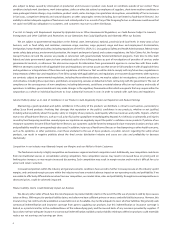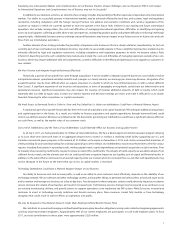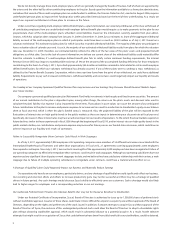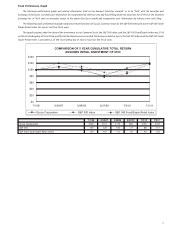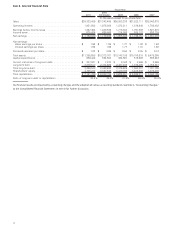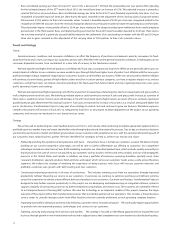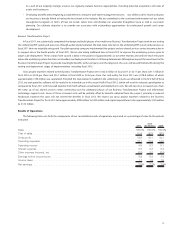Sysco 2011 Annual Report Download - page 31
Download and view the complete annual report
Please find page 31 of the 2011 Sysco annual report below. You can navigate through the pages in the report by either clicking on the pages listed below, or by using the keyword search tool below to find specific information within the annual report.Expanding into International Markets and Complimentary Lines of Business Presents Unique Challenges, and our Expansion Efforts with respect
to International Operations and Complimentary Lines of Business may not be Successful
In addition to our domestic activities, an element of our strategy includes the possibility of further expansion of operations into international
markets. Our ability to successfully operate in international markets may be adversely affected by local laws and customs, legal and regulatory
constraints, including compliance with the Foreign Corrupt Practices Act, political and economic conditions and currency regulations of the
countries or regions in which we currently operate or intend to operate in the future. Risks inherent in our existing and future international
operations also include, among others, the costs and difficulties of managing international operations, difficulties in identifying and gaining
access to local suppliers, suffering possible adverse tax consequences, maintaining product quality and greater difficulty in enforcing intellectual
property rights. Additionally, foreign currency exchange rates and fluctuations may have an impact on our future costs or on future sales and cash
flows from our international operations.
Another element of our strategy includes the possibility of expansion into businesses that are closely related or complimentary to, but not
currently part of, our core foodservice distribution business. Our ability to successfully operate in these complimentary business markets may be
adversely affected by legal and regulatory constraints, including compliance with regulatory programs to which we become subject. Risks
inherent in branching out into such complimentary markets also include the costs and difficulties of managing operations outside of our core
business, which may require additional skills and competencies, as well as difficulties in identifying and gaining access to suppliers or customers in
new markets.
We Must Finance and Integrate Acquired Businesses Effectively
Historically, a portion of our growth has come through acquisitions. If we are unable to integrate acquired businesses successfully or realize
anticipated economic, operational and other benefits and synergies in a timely manner, our earnings per share may decrease. Integration of an
acquired business may be more difficult when we acquire a business in a market in which we have limited expertise, or with a culture different
from Sysco’s. A significant expansion of our business and operations, in terms of geography or magnitude, could strain our administrative and
operational resources. Significant acquisitions may also require the issuance of material additional amounts of debt or equity, which could
materially alter our debt to equity ratio, increase our interest expense and decrease earnings per share, and make it difficult for us to obtain
favorable financing for other acquisitions or capital investments.
We Need Access to Borrowed Funds in Order to Grow and Any Default by Us Under our Indebtedness Could Have a Material Adverse Impact
A substantial part of our growth historically has been the result of acquisitions and capital expansion. We anticipate additional acquisitions
and capital expansion in the future. As a result, our inability to finance acquisitions and capital expenditures through borrowed funds could
restrict our ability to expand. Moreover, any default under the documents governing our indebtedness could have a significant adverse effect on
our cash flows, as well as the market value of our common stock.
Our Level of Indebtedness and the Terms of our Indebtedness Could Adversely Affect our Business and Liquidity Position
As of July 2, 2011, we had approximately $2.7 billion of total indebtedness. We have a Board-approved commercial paper program allowing
us to issue short-term unsecured notes in an aggregate amount not to exceed $1.3 billion; a revolving credit facility supporting our U.S. and
Canadian commercial paper programs in the amount of $1.0 billion set to expire on November 4, 2012; and certain uncommitted bank lines of
credit providing for unsecured borrowings for working capital of up to $95.0 million. Our indebtedness may increase from time to time for various
reasons, including fluctuations in operating results, working capital needs, capital expenditures and potential acquisitions or joint ventures. Prior
to maturity of our revolving credit facility, we plan to renew or extend this credit facility. The amount of credit capacity we are able to obtain, if not
sufficient for our needs, and the ultimate cost of such credit could have a negative impact on our liquidity, cost of capital and financial results. In
addition, to the extent that we decrease the amount of capacity under our revolver when it is renewed, there is a risk that such liquidity levels may
not be adequate in the future to the extent that our access to capital markets is restricted.
Technology Dependence Could have a Material Negative Impact on our Business
Our ability to decrease costs and increase profits, as well as our ability to serve customers most effectively, depends on the reliability of our
technology network. We use software and other technology systems, among other things, to generate and select orders, to load and route trucks
and to monitor and manage our business on a day-to-day basis. Any disruption to these computer systems could adversely impact our customer
service, decrease the volume of our business and result in increased costs. Furthermore, process changes may be required as we continue to use
our existing warehousing, delivery, and payroll systems to support operations as we implement the ERP system. While Sysco has invested and
continues to invest in technology security initiatives and disaster recovery plans, these measures cannot fully insulate us from technology
disruption that could result in adverse effects on operations and profits.
We may be Required to Pay Material Amounts Under Multi-Employer Defined Benefit Pension Plans
We contribute to several multi-employer defined benefit pension plans based on obligations arising under collective bargaining agreements
covering union-represented employees. Approximately 10% of our current employees are participants in such multi-employer plans. In fiscal
2011, our total contributions to these plans were approximately $32.8 million.
7




